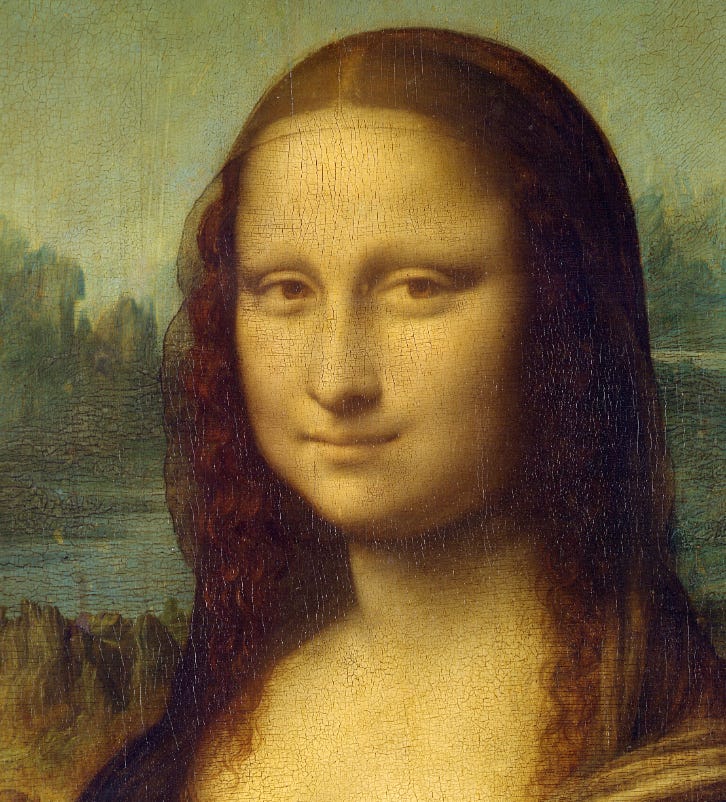TWA from Thursday, June 15, 2017 “The scent of apple cake” by Marge Piercy from Made in Detroit. © Knopf, 2015.
ORIGINAL TEXT AND AUDIO - 2017
Today is the birthday of the Italian model Lisa del Giocondo, born Lisa Gherardini in Florence (1479). We don’t know much about her childhood, but we know that when she was 15, she married a wealthy silk merchant nearly twice her age. She didn’t have a rich dowry, and most girls in her situation would not have found husbands but would have been sent to a convent, unless her family had political connections or other advantages. Lisa’s advantage was that she was beautiful, and Francesco del Giocondo was captivated by her. He arranged to marry her for a piece of her father’s farmland, and their marriage seems to have been a happy one. Francesco’s will specifically mentions her noble spirit and her faithfulness, and speaks of his love and affection for her.
In about 1503, Francesco commissioned an esteemed local artist named Leonardo to paint his wife’s portrait — possibly because the couple had just bought their house, or perhaps it was to commemorate the birth of their second son. Leonardo usually painted aristocrats, but he was between jobs at that time, and was hopeful that Francesco’s political connections could help him get some big commissions. The canvas he selected was quite large for a portrait of this type, and he also made the decision to “zoom in” pretty closely on the sitter. It seems like a small thing, but was actually revolutionary, and his choice had an immediate influence on other artists of the region. Leonardo was working on the portrait when he received a lucrative commission to paint The Battle of Anghiari — a joint project with Michelangelo to decorate the Palazzo Vecchio — so he set it aside. He took the unfinished portrait with him when he left Florence, and never delivered it to Francesco and Lisa — possibly because Francesco never paid him. Leonardo finished the portrait eventually, and it wound up in the hands of the French king Francis I.
That portrait was, of course, the Mona Lisa, and 6 million people view it at the Louvre every year. We didn’t know anything about its subject until 2005, when an expert at the University Library of Heidelberg discovered a note in the margins of a record book. The note referred to a portrait that Leonardo da Vinci was painting of Lisa del Giocondo, around the time that the Mona Lisa was known to have been painted. It gave investigators something to go on, but women’s lives were mostly unremarked upon in the early 16th century — their births, marriages, and deaths were recorded, and the baptisms of their children, but that’s about it. Journalist Dianne Hales took up the challenge and found out everything she could about the mysterious Lisa. She published her findings in Mona Lisa: A Life Discovered (2014). Hales writes: “Lisa’s life spanned the most tumultuous chapters in the history of Florence, decades of war, rebellion, invasion, siege, and conquest — and of the greatest artistic outpouring the world has ever seen.”
Francesco died in 1528, and Lisa died about four years later. She is reportedly buried at the convent of Sant’Orsola, where her daughter Marietta was a nun.
On this day in 1934, the Great Smoky Mountains National Park was founded — more than 520,000 acres of land spanning Tennessee and North Carolina. It is the most visited national park in the country, with some 10 million guests moving through each year.
Most national parks were formed from government-owned land, landscapes where few people would want to live. But the Great Smoky Mountains National Park had to be carved from the land of hundreds of small farmers who had made their homes in Appalachia for generations. More than 1,200 inhabitants were asked to leave when the park was created, leaving behind their homes and communities. Many of their original log buildings have been preserved as part of the park.
It’s the birthday of Japanese poet Kobayashi Issa, born in Kashiwabara, Japan (1763). He’s one of the masters of the Japanese form of poetry called haiku, which uses 17 Japanese characters broken into three distinct units. He spent most of his adult life traveling around Japan, writing haiku, keeping a travel diary, and visiting shrines and temples across the country. By the end of his life, he had written over 20,000 haiku celebrating the small wonders of everyday life. He’s a big reason haiku became so popular in Japan and around the world.





A tiny point regarding the Mona Lisa:
It isn’t on a canvas, rather it is painted on a poplar panel.
(Also worth noting: There are early sketches of the finished painting --done by
other, later artists-- that indicate that the original painting was square-shaped.
The standard assumption is that the picture was trimmed down to fit a frame
by a latter owner.)
I did not know the Mona Lisa story. Thank you!